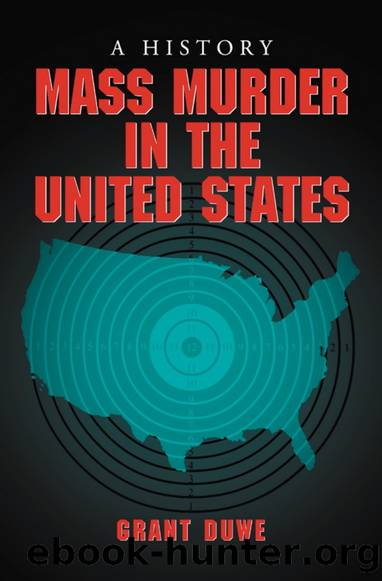Mass Murder in the United States: A History by Grant Duwe

Author:Grant Duwe [Duwe, Grant]
Language: eng
Format: epub
ISBN: 9780786431502
Google: sdd3ihupC_AC
Amazon: B00BL8V2UC
Barnesnoble: B00BL8V2UC
Goodreads: 4258022
Published: 2013-02-22T00:00:00+00:00
The accelerated tempo of mass public shootings during the 1990s was dramatized by a number of high-profile workplace massacres. In 1991, postal carriers Joseph Harris and Thomas McIlvane both committed mass murders, sealing the reputation of the U.S. Postal Service as ground zero for the alleged explosion of violence that rocked the American workforce. In the same year, physics student Gang Lu killed five at the University of Iowa. John T. Miller murdered four in New York in 1992, and Gian Luigi Ferri killed eight and wounded six at a San Francisco law office in 1993. Two years later, James Simpson and Willie Woods gunned down former co-workers in massacres they committed, while Arturo Reyes and Matthew Beck each fatally shot four victims in 1997. Finally, in 1999 Mark Barton killed twelve in Atlanta and Bryan Uyesugi gunned down seven in Honolulu.
The 1993 shooting carried out by Alan Winterbourne in Oxnard, California, provides an illustrative example of the long-term frustration often experienced by those who commit workplace massacres. After receiving a bachelorâs degree in computer science from Cal Poly San Luis Obispo in 1985, Winterbourne began working at the Northrop Corporation in September of that year. In February of 1986, however, just five months after he started, Winterbourne quit his position as computer systems engineer. Six months later, he applied for state unemployment benefits, but his request was denied on the grounds that he had left his job voluntarily (Los Angeles Times, December 4, 1993; p. 1:4). In December of 1986, when Winterbourne appealed the stateâs decision, he told the administrative law judge that he quit his job out of fear for his personal safety. He explained that he could not elaborate, however, due to government secrecy (San Diego Union-Tribune, December 4, 1993; p. A3). Years later, Winterbourne told family members he was convinced that Northrop had conspired to prevent him from ever obtaining employment again (Los Angeles Times, December 11, 1993; p. 1:2).
To a certain extent, Winterbourneâs paranoia may have been somewhat justified. After all, from 1986 to 1993 he had been rejected from every one of the 288 jobs to which he had applied. But it was not negative references from Northrop that prevented him from finding a job; rather, it was his appearance and demeanor. Winterbourne wore long hair and sported a scraggly beard. A potential employer later recalled that Winterbourne âwasnât rude or mean, there was something about him that wasnât quite right. He struck me as a bit strange, but I couldnât pinpoint quite what it was.â Another remembered that Winterbourne âjust seemed eccentricâ (Los Angeles Times, December 4, 1993; p. 1:2)
In his struggle to find work, Winterbourne ran for Congress in 1990 because he thought âit would be a good job.â In challenging incumbent Robert Lagomarsino in the Republican primary, Winterbourneâs two main issues were cutting the federal deficit and repealing the 55 m.p.h. speed limit. He lost the election, although he did receive 11.4 percent of the vote (Los Angeles Times, December 3, 1993; p.
Download
This site does not store any files on its server. We only index and link to content provided by other sites. Please contact the content providers to delete copyright contents if any and email us, we'll remove relevant links or contents immediately.
Cecilia; Or, Memoirs of an Heiress — Volume 1 by Fanny Burney(31353)
Cecilia; Or, Memoirs of an Heiress — Volume 3 by Fanny Burney(30951)
Cecilia; Or, Memoirs of an Heiress — Volume 2 by Fanny Burney(30908)
The Great Music City by Andrea Baker(21637)
We're Going to Need More Wine by Gabrielle Union(18088)
Bombshells: Glamour Girls of a Lifetime by Sullivan Steve(13120)
Pimp by Iceberg Slim(12949)
All the Missing Girls by Megan Miranda(12779)
Fifty Shades Freed by E L James(12465)
Talking to Strangers by Malcolm Gladwell(11910)
Norse Mythology by Gaiman Neil(11904)
Crazy Rich Asians by Kevin Kwan(8374)
Mindhunter: Inside the FBI's Elite Serial Crime Unit by John E. Douglas & Mark Olshaker(7851)
The Lost Art of Listening by Michael P. Nichols(6485)
Enlightenment Now: The Case for Reason, Science, Humanism, and Progress by Steven Pinker(6416)
Bad Blood by John Carreyrou(5784)
The Four Agreements by Don Miguel Ruiz(5534)
Weapons of Math Destruction by Cathy O'Neil(5049)
We Need to Talk by Celeste Headlee(4882)
